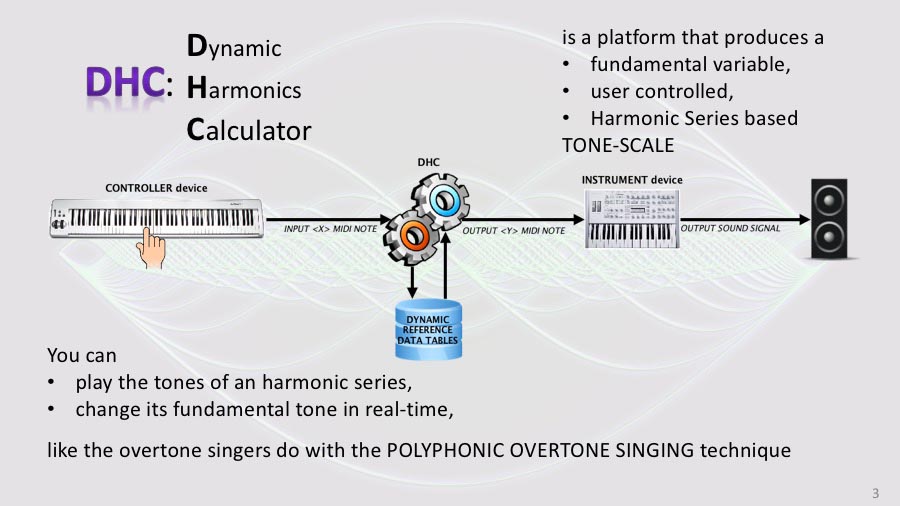Current version: 0.7.0 (Kepler)
Contents
What is this?
The Harmonicarium is a platform that allow the user/musician to play the Harmonic Series and change its fundamental tone in real-time. Just like the overtone singers do with the polyphonic overtone singing technique. The idea is to play a fundamental-variable harmonic series on electronic and electro-acoustical instruments retuned via MIDI and in real-time.
We can say it’s a microtonal music tool, specifically designed to play and explore the Harmonic Series.

It’s based on the Pure Data prototype patch “Harmonync“, developed between 2013 and 2016.
To better understand, you can read the project overview on the home site.
Harmonicarium’s source code repository is available on GitHub.
The API Documentation is available on GitHub Pages.
Potential applications
- Musical performances and playing music.
- Music composition for…
- overtone singers and choirs;
- “overtone instruments” (i.e. natural brasses/horns – or the sax altissimo technique; the Đàn bầu that use the string flageolets phenomenon);
- microtonal musicians.
- Polyrhythm composition and research.
- Research about the musical theory.
- Musicotherapy and sound therapy.
- Creative additive sound synthesis.
- Scientific probes; realtime tone/signal generation for…
- environmental acoustic tests (i.e. modal analysis);
- physical actuators (i.e. sonotrode);
- …
System requirements
Harmonicarium is written in JavaScript (used ES6 features) and uses the Web MIDI and Web AUDIO API. Currently it has been tested on Google Chrome v61+ under macOS (v10.11+), Windows (v10) and Android (v5+) but it could run on other browsers supporting both, the Web MIDI and AUDIO API (actually Opera and Microsoft Edge).
At the moment you need Google Chrome or Chromium. The software has been developed on a high performance workstation environment and currently no optimization has been made in order to minimize the computational load.
Partially untested on mobile devices. On embedded Android devices I have experienced slow data processing (delay in output audio response). This means that on low performance system you could may experience slowdowns. The Qwerty Hancock keyboard seems to support multitouch events.
Quick Start
This program is a web-app with PWA features. This means that it uses the HTML5 technology and you need a browser-container to run it. As I said at this moment you should use Chrome, but you can try also the others.
- If you don’t have Google Chrome on your system, download here and install it.
- Run the app’s URL in the browser. You can:
- open the online version harmonicarium.org/app;
- download the sources from GitHub and open “index.html” to run a local instance of the app.
How to use it?
Visit harmonicarium.org for the Tutorials. There is no comprehensive guide at this moment, it is currently being drafted. A video-guide and a step-by-step tutorial will be released as soon as possible. For any questions, do not hesitate to contact Walter Mantovani at armonici.it[at]gmail[dot]com.
Currently (February, 2022) the harmonicarium.org site still has a basic documentation but you can also visit the old project site to get more information: harmonync.harmonicarium.org
A first public document about the DHC idea
The document “A first look at THE HARMONYNC: A Dynamic Harmonics Calculator – Draft of Specifications and User Guide” is available here and has the following DOI: 10.978.88940077/01
Roadmap – Contribute… or fork!
The API Documentation is available on GitHub Pages.
From version 0.6.0 the entire code has been totally refactored to be more modular, and also the UI is become more intuitive, responsive and touch-events-compliant. The app is now a PWA (progressive web app) and so you can install it on your device if you wish.
Currently there are two main issues:
- Improve the design of the Setting panel (backend) using an UI framework. And we have to chose what to use. Currently all the UI widgets are the default broswer ones. There is no responsiveness! Use settings on mobile devices is a true hell.
- The “module” diphonicpad.js (the new UI, the frontend) is not complete yet and so is undocumented. I have to revise all the functions in it and make further testing on mobile devices. After that, I will try to make it multi-touch as well.
Having done these things, there are other two main milestones to reach:
- Add some tools for the visualization of sound: oscilloscope, lissajous curve, spectrum, spectrogram and a “tonal spiral” like this.
- Implement polyrhythms generation (nothing but harmonics in the infrasound domain).
If you have any suggestions, you can write directly to the email in the license note or use the “Issues” section of the GitHub repository. And if you are a coder, ever help is welcome!
See also the contact page on the project site.
Older versions
- Open version 0.6.0 (Galilei): App – Source code
License
Harmonicarium – a Dynamic Harmonics Calculator Copyright (C) 2017-2022 by Walter Mantovani
This program is free software: you can redistribute it and/or modify it under the terms of the GNU Affero General Public License as published by the Free Software Foundation, either version 3 of the License, or (at your option) any later version.
This program is distributed in the hope that it will be useful, but WITHOUT ANY WARRANTY; without even the implied warranty of MERCHANTABILITY or FITNESS FOR A PARTICULAR PURPOSE. See the GNU Affero General Public License for more details.
You should have received a copy of the GNU Affero General Public License along with this program. If not, see http://www.gnu.org/licenses/.
armonici.it [at] gmail [dot] com.
This content has been updated on April 13, 2023 at 1:41 am
